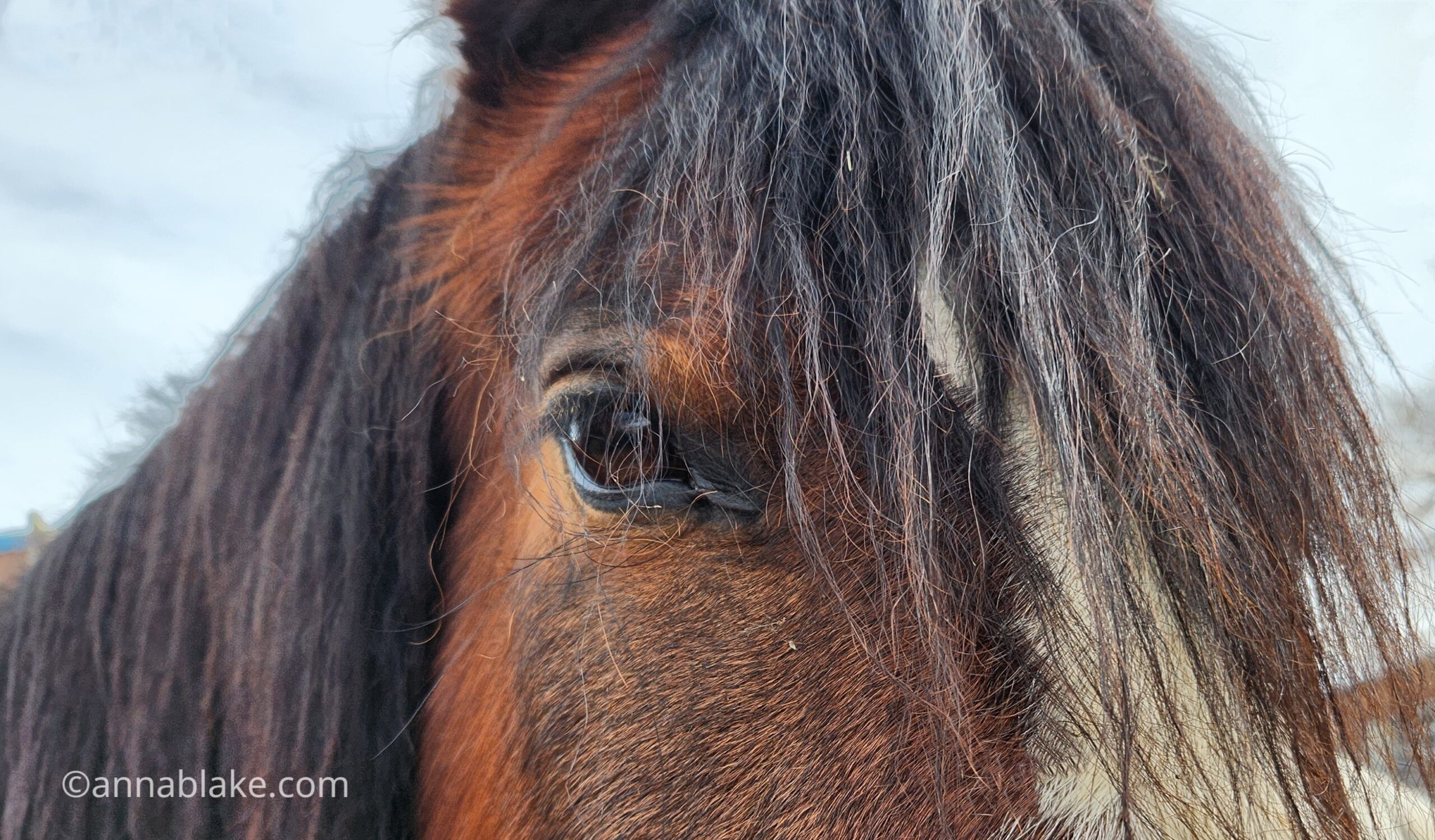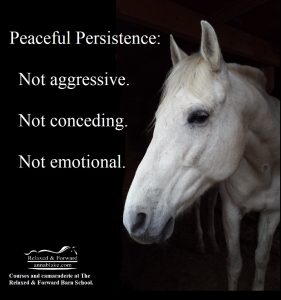
“Anna, after reading this piece I realized that I know how to do this; just not with horses. As a nurse, when I approach a frightened child or anxious adult who needs a potentially painful procedure, I change form. The angle of my head descends slightly, my gaze softens, my shoulders drop. I lower my voice and exchange my toothy grin for a closed mouth with only a slight upward turn at the corners. My movements are steady, but not rushed. I recognize their cooperation for this difficult task and I thank them.”
This comment is from Laurie, on a recent blog about when we have Coyote Eyes. It’s a beautiful description of human calming signals. She describes how she changes her body to support a patient. The message is “I’m no threat to you.” Read her description again. Easy to visualize, isn’t it? The words paint a picture that we understand because we all read body language. Because calming signals are our language as well; actions are always louder than words. But when Laurie says she knows how to communicate, “just not with horses,” I wondered if she was selling her skills short or being self-deprecating.
Then Laurie continued, “I think that 1200 pounds of muscle, bone, hooves, and teeth that can move as quickly as a snake’s strike, is surprisingly sensitive and vulnerable when interacting with us human predators. I imagine that reframing how a horse interprets humans is as hard as how a human interprets a horse, but so essential for both.”
This is so perceptive. She gets a piece here that is complicated to understand, and so difficult to get right. On one hand, is it really that different? Is talking to people different than talking to horses? Do we scare them into submission, or do we kindly de-escalate the situation? Do we show more respect for an elder? Do we respond to young horses with patience as we would children?
I hope Laurie is shaking her head at me now as if a romantic idea of being a nurse was all hand-holding and tissue passing. Do we romanticize her job as we do horses? She knows toddlers who are afraid and in pain can’t be reasonable. That adults aren’t much easier, often fearful of medical procedures or just exhausted by feeling bad. She works with people who are not at their best and she can’t control the outcome. But the only thing in her control is how she behaves. She can yield to the situation during work hours, and be who patients need her to be.
But no kidding, humans are so much easier to read than other mammals. We are transparent compared to horses and those same behaviors that work between humans will not get the same result between other species. She is right about those 1200 pounds of survival instinct. Horses are not capable of surrendering their flight response for our convenience when they feel pain and can’t get away. As much as we understand human caretaking, it is different for horses. Kissing their nose won’t make them love us. Laying on the ground next to them won’t teach them to relax. And no matter how much we love them, they will always be horses and never our children. For many horses, our affection has a dominating quality that their common horse-sense doesn’t respond to. Are we willing to listen?
The reason training techniques don’t work is that the conversation we have with each horse on any day has to be individualized. A frightened horse needs a quiet body, not threatening. We have to convince them of the impossible; that we aren’t predators and are trustworthy. Mares need us to stand tall as their equals and agreeably negotiate for what we want. I’ve never met a horse who liked people tisking and feeling sorry for them. Even when we know horses have emotions similar to ours, we have to understand those aren’t the same emotions in the same situations. Comparisons might help us have compassion, but at the same time, impede helping them. I think that’s why we get confused.
Being a nurse means that it isn’t about how they feel about the patient, it’s about how the patient feels. It’s the selfless quality in caregiving that is also required in good work with horses. It shouldn’t be how your horse makes you feel; it should be how the horse’s confidence grows with us. It isn’t that we bait them into being more human. It’s understanding that a horse’s well-being is deeply rooted in being a horse. Being true to their nature rather than having it pushed down. Listening to hear them requires us to truly release our ego so we hear what we don’t want to.
The challenge is that we must be compassionate, but we can’t see horses as human. We know calming signals, a universal language, but we need to learn the equine version. Chimps sit around hugging each other but horses have a hard-wired fear of restriction. Some run to escape, and some shut down. When rocking a child might work, horses need to move to soothe themselves. It can make us feel hopeless that our human skills don’t work.
When we go through a gate or enter the barn, we are crossing into horse territory. We are not missionaries sent to bring them salvation. It’s our job to see their side, to understand and respect their instincts. Horses are not problems to be solved or diseases to be cured. They are perfect, and in order to work with them, we have to start with accepting them as they are. In Laurie’s language, can you give the same care to a grandmother, a skinhead with swastika tattoos, or a little boy with a broken arm? Is that different than working with an elder donkey versus an off-the-track Thoroughbred or a mini-horse?
The best people at training are the best listeners. It was never about training techniques. As much as each one of us wishes there was a simple method, there isn’t. We ask questions, listen to their honest answers, and ask again but with more nuance. There are no simple answers when a predator and a flight animal negotiate a partnership. We will never have a roadmap to the stars.
Seeing it from the horse’s side doesn’t mean they never have to get vet care or that we never ask them into a trailer. It means we seek a place beyond human instinct or horse instinct. That we understand that we have to give some of who we are, as we ask the same from the horse, knowing that making either side wrong will never bring trust. Beyond human arrogance and false bravado, it’s knowing that we have as much to lose as they do.
And then putting on a small smile, “only a slight upward turn at the corners,” we get to the business of giving the horse what they need to survive in our world.
…
If you appreciate what I do, please Subscribe to this blog or join us at The Barn School.

Anna Blake, Relaxed & Forward
Want more? Become a “Barnie.” Subscribe to our online training group with affirmative demonstration videos, audio blogs, daily quotes, free participation in “group lessons”, and live chats with Anna. Become part of the most supportive group of like-minded horsepeople anywhere.
Anna teaches ongoing courses like Calming Signals and Affirmative Training at The Barn School, along with virtual clinics and our infamous Happy Hour. Everyone’s welcome.
Visit annablake.com to find archived blogs, purchase signed books, schedule a live consultation, subscribe for email delivery of this blog, or ask a question about the art and science of working with horses.
Anna yes.
Laurie Ahh Yess.
And as you know as well. Thanks, Kim.
“Horses are not problems to be solved or diseases to be cured”.
Oops, I’m definitely GUILTY! Through my caretaking lens I have viewed my newest rescue’s (Ferd & Noche) significantly different and somewhat intimidating behavior as something that needed to be fixed instead of understood. With life’s multiple pressures it’s hard to always be in the moment, but when I am able to stop, breathe, observe, and try to understand rather than demand, I see a subtle relaxation in their bodies and softening in their eyes. This gives me hope for increasingly trusting relationships as time goes on. Partnership is hard work and an extraordinary exercise in selflessness.
Thank you Anna. I don’t know where I would be without your rare ability to articulate and share your wisdom.
And thank you for this blog idea. I know you have the skills for this. But to push the analogy, these horses of yours are dealing with something chronic, I fear. But the small change you see is real, and it will continue. Horses pick the time spent, that’s the challenge. Thanks, again Laurie. I want to fix them all, too.
This blog resonates with me so much. The lessons of letting go of ego to truly give to other creatures is so well articulated in this blog. I’m an educator of adolescents, and this is giving me so much to think about and connect with.
This is truth. Hard truth. Beautifully and soulfully conveyed.
Kids and horses are not the same, but I sure think of kids when I write about horses. Thanks for what you do, Karen, teachers are heroes.